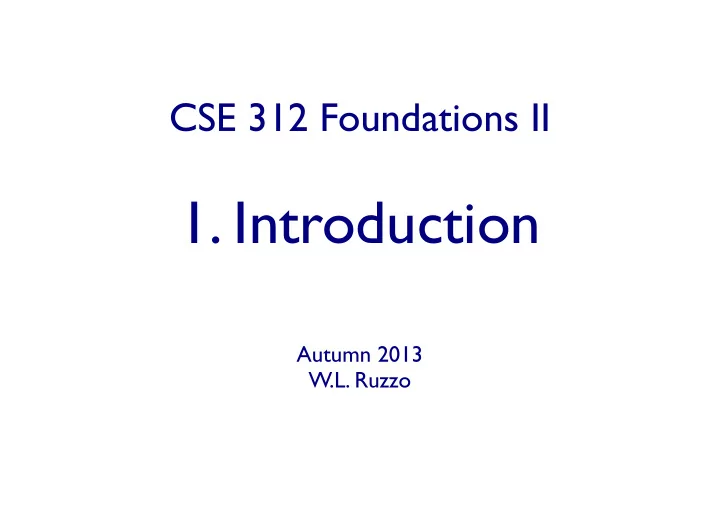

CSE 312 Foundations II 1. Introduction Autumn 2013 W.L. Ruzzo
CSE 312, Au '13: Foundations of Computing II CSE Home About Us Search Contact Info Administrative Lecture: MGH 241 (schematic) MWF 1:30- 2:20 Schedule & Reading Section A: MGH 242 (schematic) Th 1:30- 2:20 Sonya Alexandrova Course Email/BBoard Section B: MGH 228 (schematic) Th 2:30- 3:20 Scott Lundberg Subscription Options Section C: MEB 243 (schematic) Th 12:30- 1:20 Yanling He Class List Archive E-mail Course Staff GoPost BBoard Office Hours Location Phone Instructor: Larry Ruzzo, ruzzo cs F 2:30- 3:20 CSE 554 543-6298 Lecture Notes 1: Intro TAs: Sonya Alexandrova, sonyaa cs M 4:30- 5:30 CSE 216 2: Counting Scott Lundberg, slund1 cs Tu 4:30- 5:30 CSE 2xx Lecture Recordings Yanling He, heyl cs M 3:30- 4:30 CSE 2xx 0: Help 1: Sep 25 [get .zip] Course Email: cse312a_au13@uw.edu. Staff announcements and general interest student/staff Resources Q&A about homework, lectures, etc. The instructor and TA are subscribed to this list. Enrolled LaTeX Quickstart students are as well, but probably should change their default subscription options. Messages are http://courses.cs.washington.edu/cse312 automatically archived. Discussion Board: Also feel free to use Catalyst GoPost to discuss homework, etc. Catalog Description: Examines fundamentals of enumeration and discrete probability; applications of randomness to computing; polynomial-time versus NP; and NP-completeness. Prerequisites: CSE 311; CSE 332, which may be taken concurrently. Credits: 4 Learning Objectives: Course goals include an appreciation and introductory understanding of (1) methods of counting and basic combinatorics, (2) the language of probability for expressing and analyzing randomness and uncertainty (3) properties of randomness and their application in designing and analyzing computational systems and (4) some basic methods of statistics and their use in a computer science & engineering context. Grading: Homework, Midterm, Final. Possibly some quizes, small programming assignments.
a definition Empiricism: 1. Relying on observation and experiment, esp. in the natural sciences 2. A former school of medical practice founded on experience without the aid of science or theory Synonym: Quackery, Charlatanry merriam-webster.com 3
Study Probability! “Life is uncertain. Eat dessert first.” -- Ernestine Ulmer
syllabus Counting & Binomial Coeffs: (1wk) Statistics (3 wks) • Sum and product rules, product trees, • Parameter estimation: confidence Permutations and Combinations, intervals, bias; maximum likelihood: Inclusion-Exclusion, Binomial Theorem, binomial, normal, EM Pigeonhole Principle • Hypothesis Testing: likelihood ratio, t- Probability (5 wks) test, contingency tables & chi-squared test? • Basics: Sample spaces, events, (e.g. coins, • Monte-Carlo simulation, polling and dice, cards, program bugs?) sampling? • Conditional probability & Bayes • Bayesian estimation, Bayes classifier, theorem, ex: false positive/negative, machine learning spam detection • How to lie with statistics • Random variables: independence, expectation, linearity of expectation, variance • Bernoulli trials, binomial, multinomial? distributions; Poisson approximation • Tail bounds (Markov, Chebyshev, Chernoff) • Continuous random variables; exponential and normal, central limit theorem • Applications: average case vs random algs, hashing, fingerprinting, load balancing, entropy and data compression 5
CSE applications (some examples) - Performance analysis: “events” happen randomly, unpredictable failures, unpredictable arrival of data, varying workloads, ... - “Knowledge discovery,” data mining, AI, ... statistical descriptions of patterns in data - Scientific data analysis: measurement errors and artifacts - Uncertainty: navigation and control with noisy sensors, ... - Algorithm design and analysis: sometimes a randomized approach is simpler or better than any known deterministic one. 6
beyond CSE Read the paper, listen to the news, surf the web. You’ll be bombarded with statistics – most of it phrased so as to bias the conclusion they hope you will draw. Defend yourself! 7
Recommend
More recommend